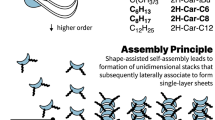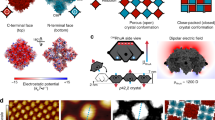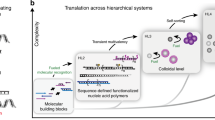Abstract
The production of functional molecular architectures through self-assembly is commonplace in biology, but despite advances1,2,3, it is still a major challenge to achieve similar complexity in the laboratory. Self-assembled structures that are reproducible and virtually defect free are of interest for applications in three-dimensional cell culture4,5, templating6, biosensing7 and supramolecular electronics8. Here, we report the use of reversible enzyme-catalysed reactions to drive self-assembly. In this approach, the self-assembly of aromatic short peptide derivatives9,10 provides a driving force that enables a protease enzyme to produce building blocks in a reversible and spatially confined manner. We demonstrate that this system combines three features: (i) self-correction—fully reversible self-assembly under thermodynamic control; (ii) component-selection—the ability to amplify the most stable molecular self-assembly structures in dynamic combinatorial libraries11,12,13; and (iii) spatiotemporal confinement of nucleation and structure growth. Enzyme-assisted self-assembly therefore provides control in bottom-up fabrication of nanomaterials that could ultimately lead to functional nanostructures with enhanced complexities and fewer defects.
This is a preview of subscription content, access via your institution
Access options
Subscribe to this journal
Receive 12 print issues and online access
$259.00 per year
only $21.58 per issue
Buy this article
- Purchase on Springer Link
- Instant access to full article PDF
Prices may be subject to local taxes which are calculated during checkout




Similar content being viewed by others
References
Whitesides, G. M. & Boncheva, M. Beyond molecules: Self-assembly of mesoscopic and macroscopic components. Proc. Natl Acad. Sci. USA 99, 4769–4774 (2002).
Lehn, J.-M. Supramolecular Chemistry: Concepts and Perspectives (VCH, 1995).
Jonkheijm, P., van der Schoot, P., Schenning, A. P. H. J. & Meijer, E. W. Probing the solvent-assisted nucleation pathway in chemical self-assembly. Science 313, 80–83 (2006).
Silva, G. A. et al. Selective differentiation of neural progenitor cells by high-epitope density nanofibers. Science 303, 1352–1355 (2004).
Zhang, S. G., Holmes, T., Lockshin, C. & Rich, A. Spontaneous assembly of a self complementary oligopeptide to form a stable macroscopic membrane. Proc. Natl Acad. Sci. USA 90, 3334–3338 (1993).
Reches, M. & Gazit, E. Casting metal nanowires within discrete self-assembled peptide nanotubes. Science 300, 625–627 (2003).
Kiyonaka, S. et al. Semi-wet peptide/protein array using supramolecular hydrogel. Nature Mater. 3, 58–64 (2004).
Schenning, A. P. H. J. & Meijer, E. W. Supramolecular electronics; nanowires from self-assembled π-conjugated systems. Chem. Commun. 26, 3245–3258 (2005).
Yang, Z. M. et al. Enzymatic formation of supramolecular hydrogels. Adv. Mater. 16, 1440–1444 (2004).
Smith, A. M. et al. Fmoc-Diphenylalanine self assembles to a hydrogel via a novel architecture based on π–π interlocked β-sheets. Adv. Mater. 20, 37–41 (2008).
Corbett, P. T. et al. Dynamic combinatorial chemistry. Chem. Rev. 106, 3652–3711 (2006).
Rowan, S. J., Cantrill, S. J., Cousins, G. R. L., Sanders, J. K. M. & Stoddart, J. F. Dynamic covalent chemistry. Angew. Chem. Int. Ed. 41, 898–952 (2002).
Sreenivasachary, N. & Lehn, J. M. Gelation-driven component selection in the generation of constitutional dynamic hydrogels based on guanine-quartet formation. Proc. Natl Acad. Sci. USA 102, 5938–5943 (2005).
Winkler, S., Wilson, D. & Kaplan, D. L. Controlling β-sheet assembly in genetically engineered silk by enzymatic phosphorylation/dephosphorylation. Biochemistry 39, 12739–12746 (2000).
Yang, Z., Liang, G., Ma, M., Gao, Y. & Xu, B. In vitro and in vivo enzymatic formation of supramolecular hydrogels based on self-assembled nanofibers of a β-amino acid derivative. Small 3, 558–562 (2007).
Dos Santos, S. et al. Switch-peptides: Controlling self-assembly of amyloid β-derived peptides in vitro by consecutive triggering of acyl migrations. J. Am. Chem. Soc. 127, 11888–11889 (2005).
Hu, B.-H. & Messersmith P. B. Rational design of transglutaminase substrate peptides for rapid enzymatic formation of hydrogels. J. Am. Chem. Soc. 125, 14298–14299 (2003).
Um, S. H. et al. Enzyme-catalysed assembly of DNA hydrogel. Nature Mater. 5, 797–801 (2006).
Carpenter, F. H. The free energy change in hydrolytic reactions. The non-ionized compound convention. J. Am. Chem. Soc. 82, 1111–1122 (1960).
Toledano, S., Williams, R. J., Jayawarna, V. & Ulijn, R. V. Enzyme-triggered self-assembly of peptide hydrogels via reversed hydrolysis. J. Am. Chem. Soc. 128, 1070–1071 (2006).
Oh, K., Jeong, K.-S. & Moore, J. S. Folding-driven synthesis of oligomers. Nature 414, 889–893 (2001).
Bilgicer, B., Xing, X. & Kumar, K. Programmed self-sorting of coiled coils with leucine and hexafluoroleucine cores. J. Am. Chem. Soc. 123, 11815–11816 (2001).
Krishnan-Ghosh, Y. & Balasubramanian, S. Dynamic covalent chemistry on self-templating peptides: Formation of a disulfide-linked β-hairpin mimic. Angew. Chem. Int. Ed. 42, 2171–2173 (2003).
Case, M. A. & McLendon, G. L. A virtual library approach to investigate protein folding and internal packing. J. Am. Chem. Soc. 122, 8089–8090 (2000).
Swann, P. G. et al. Nonspecific protease-catalyzed hydrolysis synthesis of a mixture of peptides: Product diversity and ligand amplification by a molecular trap. Biopolymers 40, 617–625 (1996).
Forster, T. Excimers. Angew. Chem. Int. Ed. 8, 333–343 (1969).
Pinion, J. P., Minn, F. L. & Filipescu, N. Excimer emission from dibenzofuran and substituted fluorenes. J. Lumin. 3, 245–252 (1971).
Aggelli, A. et al. Responsive gels formed by the spontaneous self-assembly of peptides into polymeric β-sheet tapes. Nature 386, 259–262 (1997).
Lins, R. J., Flitsch, S. L., Turner, N. J., Irving, E. & Brown, S. A. Enzymatic generation and in situ screening of a dynamic combinatorial library of sialic acid analogues. Angew. Chem. Int. Ed. 41, 3405–3407 (2002).
Mann, S. Life as a nanoscale phenomenon. Angew. Chem. Int. Ed. 47, 5306–5320 (2008).
Acknowledgements
We thank the Engineering and Physical Sciences Research Council and the Leverhulme Trust for funding, P. Crook for assistance with infrared spectroscopy, S. Todd for assistance with surface modification, P. Coppo and T. Jowitt for assistance with fluorescence, and V. Barittini for mass spectrometry. N.H. acknowledges the support of the UK Centre for Tissue Regeneration (a partnership between NorthWest Development Agency and University of Manchester, UK). R.V.U. acknowledges P. Halling for his careful reading of the manuscript and for providing helpful suggestions.
Author information
Authors and Affiliations
Contributions
R.V.U. conceived the concepts and helped design the experiments. R.J.W., A.K.D., A.M.S., R.C. and N.H. designed and performed the experiments and analysed the data. All authors co-wrote the paper.
Corresponding author
Supplementary information
Supplementary Information
Supplementary Information (PDF 1496 kb)
Rights and permissions
About this article
Cite this article
Williams, R., Smith, A., Collins, R. et al. Enzyme-assisted self-assembly under thermodynamic control. Nature Nanotech 4, 19–24 (2009). https://doi.org/10.1038/nnano.2008.378
Received:
Accepted:
Published:
Issue Date:
DOI: https://doi.org/10.1038/nnano.2008.378
This article is cited by
-
Assembly drives regioselective azide-alkyne cycloaddition reaction
Nature Communications (2023)
-
In situ self-assembly for cancer therapy and imaging
Nature Reviews Materials (2023)
-
Biomimetic hydrogel scaffolds via enzymatic reaction for cartilage tissue engineering
BMC Research Notes (2022)
-
Bio-derived crystalline silk nanosheets for versatile macroscopic assemblies
Nano Research (2022)
-
Reaction-diffusion hydrogels from urease enzyme particles for patterned coatings
Communications Chemistry (2021)



